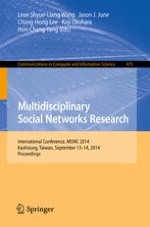2014 | Book
Multidisciplinary Social Networks Research
International Conference, MISNC 2014, Kaohsiung, Taiwan, September 13-14, 2014. Proceedings
Editors: Leon Shyue-Liang Wang, Jason J. June, Chung-Hong Lee, Koji Okuhara, Hsin-Chang Yang
Publisher: Springer Berlin Heidelberg
Book Series : Communications in Computer and Information Science
